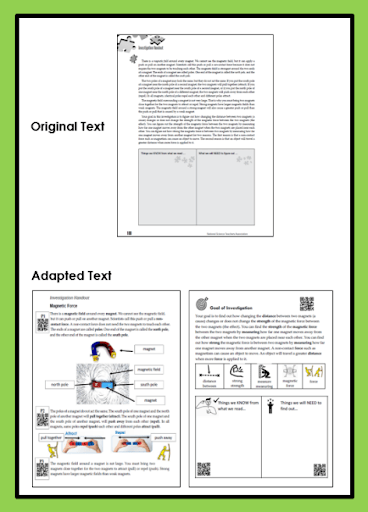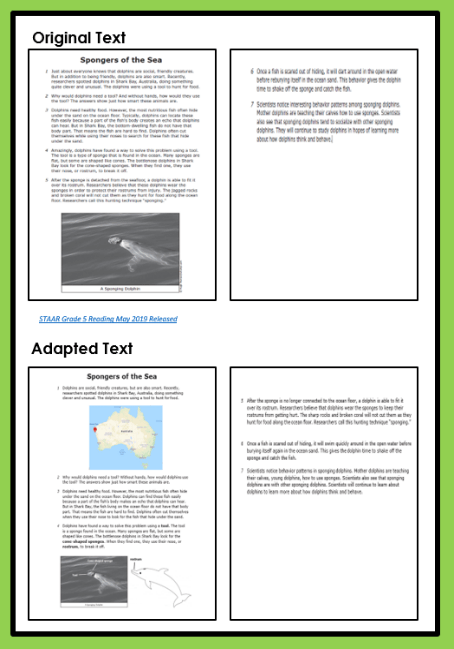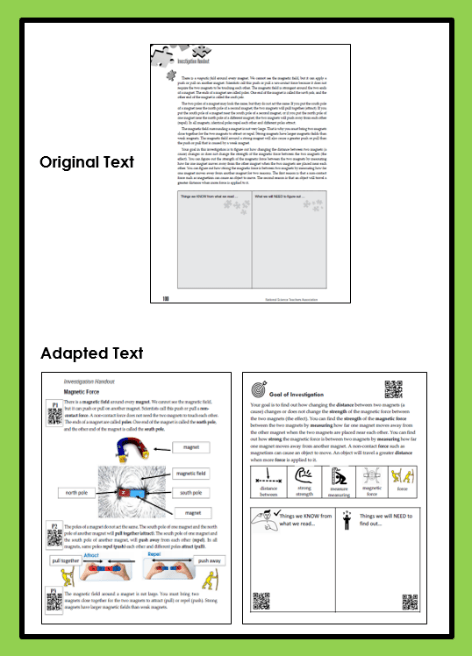by Carmen Nguyen
During this time of uncertainty, we are faced with many challenges that detrimentally affect and change how we are teaching. Whether we are teaching in a traditional face-to-face setting, completely virtually, or a hybrid of the two, it remains true that, as educators, we will continue to create, find, or purchase a variety of resources for the students we serve. Unfortunately, it is also true that the Lexile level of the grade level resources we have access to is not always appropriate for the various students in our classrooms. It is often difficult to find resources that are authentic and challenging and address grade-appropriate concepts, but are also at the students’ reading level. As educators we find ourselves adapting, changing, or supplementing the resources we have in order to teach our state-mandated curriculum.
Now, let’s simply consider how to adapt the text in the resources we use in our classroom to make them more accessible for students who are not yet able to read grade-level appropriate text. Too often when text is adapted, it is stripped of all of the features we initially selected it for. It is important to take note that exposing students to complex text as well as the meaningful language structures found within the text offers students avenues for literacy development as well as grade level readiness. So offering a balance is key to ensuring students are able to meaningfully interact with the text. ASCD offers a publication that provides an in depth resource to understanding and evaluating text complexity.
There are several online platforms that provide leveled text and websites that will adjust the level of the text, but many times the adjusted text is still not what you need, or the information you needed is now removed. The following steps will help guide you in adapting texts or resources yourself while maintaining the rich features in the original text.
Step 1: Determine the Goal for Using the Text
Before you begin adapting a specific text or resource, you must determine what the goal of reading or using the text is. Are you using the text for students to acquire knowledge about a specific concept or topic? Or are you reviewing the text features to analyze the text for a specific purpose? The goal is really driven by the standards you are teaching, and how you adapt the text will vary based on a variety of factors:
- Different content areas
- Types of text
- Whether the students will be interacting with the text independently, in a partnership/group, or with guidance from the teacher
- Whether the text you created is an electronic version or printed
Step 2: Read Text Using Different Lenses
This may sound obvious, but in order to adapt the text you will have to read the text thoroughly and possibly multiple times using different lenses. The chart below describes the lenses you may need to use:
| 1st Read: Understanding |
| Read the text simply to determine what the text is about. |
| 2nd Read: Information |
| Identify what you would like for the students to learn from reading the text (ties back to the goal for selecting the text). What are the key points? What must remain in the text? What information is necessary for students to accomplish the task? |
| 3rd Read: Identification |
| Identify vocabulary, phrases, or possibly even sentences that may be potentially difficult for the reader, are central to understanding, are used frequently in the text, are cross-curricular, have multiple meanings, and contain affixes (include sections that had you reference another part of the text or sections you may have had to reread for understanding). It is always good practice to categorize the vocabulary you identify into three tiers. – Tier 1: Commonly Used Words – Tier 2: Cross-Curricular Words – Tier 3: Content Specific Words ¡Colorín Colorado! offers a great article with a further explanation on the differences among the tiers. If you have text in an electronic format or that is short and you do not mind typing in, this can be easily done using the Longman Dictionaries Vocabulary Checker. |
Step 3: Decide Which Student/s or Group/s Will Receive the Adapted Text
Knowing who the adapted text is for will help you determine the level of scaffolds you will need to embed. Consider reviewing students’ reading levels and their descriptors and English proficiency levels and their descriptors. The descriptors will guide you in selecting scaffolds that will ensure students can successfully and authentically interact with the text and help move them forward.
Step 4: Determine Whether or Not Clarity is Needed
Now that you have identified who would benefit from utilizing the adapted text and have reviewed their reading and linguistic levels, you will need to determine whether or not clarification is needed for the words/phrases/sentences/sections you previously selected. It is beneficial to clarify only what will enhance understanding and provide enough access to help students accomplish the desired task or objective. When determining whether clarity is needed, consider categorizing items into what you must do to enhance understanding. The chart below provides a few examples:
| YES | NO | |
| Is the information necessary for the students to accomplish the task? | Simplify | Delete |
| Is the information written in a clear, concise manner? | Leave it alone or Enhance | Enhance,Simplify, Delete |
| Are there vocabulary words that a student must know to meet grade level expectations? | Enhance | Simplify or Delete |
| Does the text contain charts, tables, pictures, diagrams, photographs? | Leave it alone or Enhance | Enhance |
You may also find it beneficial to review the scoring rubrics found on the ASCD publication referenced above.
Step 5: Select and Add Features to the Text to Enhance the Readability
When selecting features to add to the text or resources, make sure to reference the goal for using the text (step 1) and be mindful of who you are scaffolding for (step 3). When you are learning or just beginning to dabble with adding features to text or resources, it is common to over scaffold. As you gain practice and find what works best for your students, you can gradually remove scaffolds. The same concept applies when you model for or guide students: you provide substantial supports at the beginning, and as students become successful, you gradually remove the supports. The chart below provides possible features that may improve the readability of text/resources and can be done either on printed or online resources:
| Feature | Suggestion |
| Simplify Text | – Use simpler language or language that mirrors student proficiency level – Remove unnecessary or confusing words and nonessential information – Add redundancy if appropriate (repeatedly name objects/people/concepts) |
| Chunk Text | – Create smaller, manageable sections within the text – Add additional headings |
| Add Visual Supports | – Use consistent charts, tables, pictures, diagrams, and photographs to support text – Add captions to pictures when appropriate – Add clear labels to visuals |
| Vocabulary | – Identify, highlight, or bold key vocabulary – Provide a word bank with visual supports – Add student-friendly definitions to the text – Use synonyms if not essential vocabulary |
| Text-to-Speech | – Add oral read aloud to the text (add QR codes for printed text) |
Here are a few examples to help you visualize potential ways to adapt text/resources.
A last piece of advice is to not overwhelm yourself with too many supports. Begin with embedding features that will give students just enough access and move forward from there. Yes, adapting texts or resources does take time and practice. But all things worth doing take time.
References:
Close Look at Close Reading: Teaching Students to Analyze Complex Texts, Grades K–5
by Diane Lapp, Barbara Moss, Maria Grant and Kelly Johnson
http://www.ascd.org/publications/books/114008/chapters/Understanding-and-Evaluating-Text-Complexity.aspx#:~:text=What%20exactly%20does%20the%20term,answers%20to%20Questions%205%E2%80%939.
Selecting Vocabulary Words to Teach English Language Learners
From ¡Colorín Colorado!
https://www.colorincolorado.org/article/selecting-vocabulary-words-teach-english-language-learne
Mathematical Thinking and Communication Access for English Learners
By Dridcoll, Nikula, DePiper



2 thoughts on “Transforming the Resources You Have into Accessible Formats for All Students”